P:O.V. No.1
La Vis: Making Sense of the Ending
Richard Raskin
We have met the enemy and
he is us.
Pogo (American comic strip)
From the very beginning, La Vis makes special demands of the viewer, for example with respect to guessing what is said in the nonsense languages spoken, as well as adapting to a geographically disorienting décor and to a style of acting and staging that is clearly parodistic, though just whom or what the film is making fun of is left unclear. However, the last last fifteen shots of the film, beginning with the arrival of the worker who has been summoned to the general manager's office, are puzzling in their own way and offer an even greater challenge to our decoding and interpretive abilities.
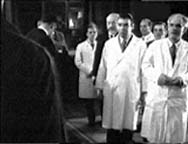
|
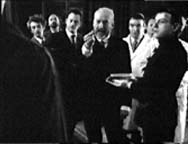
|
|
1. The worker enters our field of vision with his back to the camera, so that only his right shoulder is visible to us. Facing him (and us) are Mr. K as well as eight or nine of the designers and engineers of Metallika. On seeingthe worker's face, Mr. K is visibly shaken: he looks down, turns away and removes his glasses, as the general manager enters from the right, along with an usher carrying the famous screw on a silver tray. Accusingly the general manager holds up the screw and intones: "Harekt aviskia?" [presumably: "Did you do this?"]
|
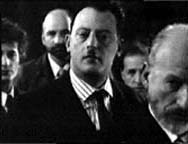
2. All eyes are on the worker (off camera). Again the general manager reproachfully asks: "Harekt aviskia?"
|
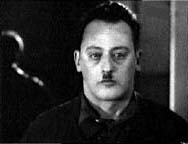
3. The worker is now seen frontally for the first time: he looks exactly like Mr. K, and swallows uncomfortably.
|
|
4. As in 2. The group moves forward, the director saying: "Ha doch"
[presumably: "Speak up"].
|

5. The worker struggles to form a word that starts with a "k" sound. He looks over toward Mr. K.
|
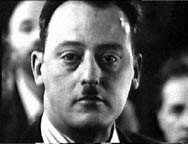
6. Mr. K swallows hard.
|
7. Close shot of the worker, who manages to say the word "clou" [nail] but barely intelligibly.
8. Mr K and the general manager listen.
9. Close shot of the worker, who now manages to say "clou" and laughs.
|
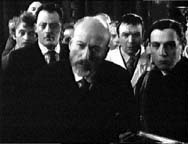
10. The general manager approaches and asks "Clow?"
|
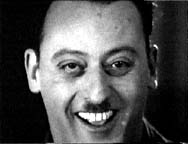
11. The worker laughs and says "clou" several times.
|
12. Brief shot of the general manager and others, trying to comprehend.
|
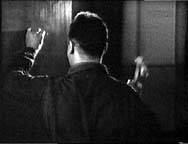
13. The worker turns to the wooden wall behind him, laughs and says "clou" while hammering the screw into the wood.
|
|
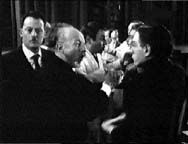
|
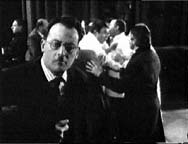
|
|
14. The general manager turns to his colleagues, asking "clou?" All the Metallika people repeat "Clou?" to one another, then realise what it means and exhibit great relief and jubilation. As their excitement grows., they recede toward the background, leaving Mr K alone in the foreground as they congratulate each other. Pensively Mr. K looks down at the eyeglasses, still in his hand, then puts them on, comes closer to the wall (off camera) into which the screw has been hammered and leans forward, looking at the screw.
|
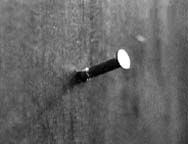
15. Insert of the screw that has been hammered halfway into the wall.
|
|
One of the principal issues we have to deal with in attempting to make sense of
the ending, is the fact that the culprit - the worker responsible for making
the defective screw - turns out to be Mr. K's double.
This could, of course, be written off as a gag of the type we had seen in the
elevator, when two minor characters, played by identical twins, notice with
some perplexity that they look alike and can't keep their eyes off each other.
However, in this final scene, the identity of the doubles plays too pivotal a
role to be perceived as a gag.
One way to understand what the film suggests with respect to these doubles, is
in terms of a proposition: that hunting for a culprit may boomerang back upon
the hunter, in the sense that he may see himself in the prey, once the
prey is caught. That Mr. K removes his glasses and turns away upon seeing the
guilty worker (shot 1 above) could be understood as a sign not only that he is
upset but also that he doesn't want to see what now is evident: that the man he
has unwittingly manoeuvred into the role of victim is a person exactly
like himself. In this context, we could understand that Mr. K would never
have pursued his campaign of righteous indignation in the first place if he had
foreseen where it would lead. The fact that no one other than Mr. K and the
worker seems to notice their resemblance, wouldn't necessarily discredit the
hypothesis since it involves a subjective relationship between accuser and
accused. Nevertheless, the evidence in support of this reading is far from
overwhelming.
Another possibility worth considering is that the doubles are two aspects of
the same person, in which case the worker would not be someone
like Mr. K but Mr. K himself, in a different social role. Like Oedipus
hunting for the murderer of Laius and coming to the realisation that the
assassin was none other than himself, Mr. K would discover that he and the
culprit were one and the same person. However, this hypothesis makes no sense
whatsoever with respect to the fabrication of the screw, and on those grounds
alone is hardly viable; and the fact that no one else seems to notice the
identity of the two men, would be impossible to explain in this context.
Yet another possibility would be to see the story as a social allegory of the
type Kafka wrote, in which case Metallika would presumably represent a Central
European bureaucracy imbued with authoritarianism, incompetence and a downward
flow of blame whenever anything goes wrong. Yet our Mr. K - unlike Kafka's
victims - succeeds in penetrating and mobilizing the formidable hierarchy, and
until the final moment, the man who chooses to defy the system has the upper
hand. When he ultimately loses the game, it is not because he has been caught
like a helpless insect in a spider's web, but because someone like him who is
also playing the game, manages to invent a winning move in order to save his
own skin.[1 ]But does any of this bring us
closer to understanding how we are to interpret the fact that Mr. K and the
worker turn out to be doubles?
My own view is that the doubles are more a structural need of the story than a
vehicle of meaning (though one doesn't necessarily exclude the other). Given
the premise of the story, the hunt for a culprit has to end somewhere and the
moment of discovery has to deliver a surprise: what better way to manage that
moment, in visual storytelling terms, than by using the device of the doubles,
even if the identity of accuser and accused may resist whatever interpretive
hypotheses the viewer might try to construct? In a moment, I will return to
other structural purposes served by the doubles.
The designated victim - the worker played by the same Jean Reno who plays Mr. K
- soon manages to turn the tables on his accusers, when he declares the screw
to be nail. Here, we are expected to understand that the worker is engaged in a
purely tactical manoeuvre in order to save his own skin, and that the ploy
works.
That the writer/director - Didier Flamand - intended it to be seen in those
terms is confirmed by two pre-production scripts he graciously sent to me, in
both of which the same sentence appears: "The worker brandishes the screw, and,
in a stroke of sudden inspiration, shouts: Nail!" ("L'ouvrier brandit la vis,
et, sous le coup d'une inspiration soudaine, s'écrie: Klou!"). The
worker's triumphant laughter helps to mystify his powerful inquisitors, and
although his claim is patently false - and in hammering the screw into wood, he
commits a sin that would make any craftsman cringe - we are implicitly invited
to applaud his resourcefulness in this critical moment.
Instead of giving up, he finds a way to turn the situation around and gets away
with it. And he does this by giving the company a dose of its own medecine:
"demonztrazion". In his own monosyllabic way, he makes a pitch as phoney as the
ones we had seen at the various stands earlier in the film, and manages to sell
his distinguished public on the idea that the defective screw is actually an
ideal nail.[2]
In the process, our identification with Mr. K - built up as he single-handedly
took on successive layers of the Metallika hierarchy, eventually working his
way up to the general manager - is now transferred to his double at the bottom
of the hierarchy, who successfully outwits his superiors. The worker slips
away, leaving his employers to the self-congratulatory euphoria he tricked them
into experiencing, and leaving Mr. K. deflated and marginalized.
From one moment to the next, the Metallika people lose interest in Mr. K and
physically withdraw from him, leaving him alone to contemplate the object which
had until then been his vehicle for gaining access to exclusive circles of
power, but now embodies his sudden and unexpected defeat.
Reduced to a passive role, he is no longer our man in the film. As
already suggested, our identification is transferred from Mr. K to the worker,
whose properties as underdog and successful trickster make him appealing in our
eyes, and whose resemblance to Mr. K greatly facilitates the transference of
our identification. This is a second structural advantage to using the device
of the double.
In other words, in making the culprit the double of his hunter, Didier Flamand
was able to give the moment of discovery the kind of surpise that had to
characterize that event, while also enabling us to transfer our identification
easily to the new role played by Jean Reno.
Yet a third structural advantage springs from the fact that in having the
accused turn out to be the same person as the accuser, the story has naturally
come full circle, doubling back upon itself, and achieving thereby a sufficient
degree of closure to leave us satisfied that it is complete, even though it
remains very much open-ended - if not outright resistant - with respect to
possible meanings.
[1] In both pre-production screenplays, it is Mr. K who becomes the
object of the hierarchy's reproachful scrutiny at the end of the film: "By the
fact that the color suddenly drains from his face, we understand that it is
toward him that all eyes are now turned" ("A la pâleur subite qui envahit
son visage, on comprend que c'est vers lui, maintenant, que les regards se
tournent"). And in the later of the two scripts, Didier Flamand added: "The
general manager turns toward [Mr. K] and questions him... [Mr. K] does not
answer. His mouth slowly widens, in the grip of stupefaction or terror" ("Le
directeur se tourne vers le bricoleur et lui pose une question... Le bricoleur
ne répond pas. Sa bouche s'élargit lentement, sous le coup de la
stupéfaction ou de l'épouvante."). This more kafkaesque ending,
in which Mr. K himself slides into the victim role of the inquiry he had
launched, is not included in the film.
[2] An alternate hypothesis - that the worker is actually
inventing a new concept: that of the nail - is also worth considering,
especially (but not only) since that would also fit with the screenplay's
"stroke of sudden inspiration" cited above. However, the Metallika hierarchy's
jubilation at the end of the film is dependent on their having a concept of the
nail, and on their being sold on shifting their normative parameters from
screw-concept to nail-concept. The recognition expressed in their final
utterances on screen would, I believe, rule out the possibility that the worker
is to be understood as inventing the nail.











